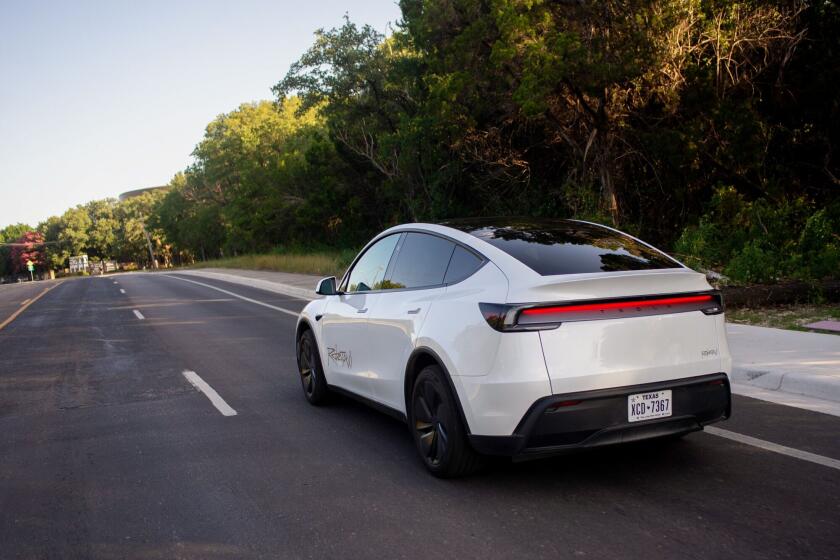What’s So Silly About a Bargain Freeway?
- Share via
This year we celebrated the 20th anniversary of man walking on the moon. Thirty years ago, however, most Americans considered the very thought to be unrealistic--a childish science-fiction fantasy.
Raw determination and high technology proved a lot of people wrong. I make note of this to emphasize the importance of exploration, even on much smaller scales. Specifically I am referring to my recent proposal to explore the feasibility of turning parts of the Los Angeles River channel into a commuter expressway and truck thoroughfare. The proposal could result in a 20% reduction in traffic on the Ventura Freeway during peak hours.
I am the first to admit that the idea is unconventional. Still, the transportation crisis in Los Angeles is so severe that we can’t afford to overlook any potential solution just because it hasn’t been tried.
The beauty of the plan is its balanced approach: In addition to alleviating traffic congestion, it provides for the environmental enhancement of the basin by greenbelting with trees, bikeways and “pocket parks.” Plus, it’s relatively inexpensive.
Here’s how it would work:
One-third of the Los Angeles River flood channel would be used for two or three reversible high-occupancy vehicle express lanes for car pools, van pools and alternative- fuel buses from the west San Fernando Valley to downtown Los Angeles.
Two-thirds of the channel would still serve for flood control and would be divided from the express lanes by a 10-foot-high retaining wall. We generally are able to anticipate storms in Los Angeles days in advance, so the lanes could be closed before any potential flooding occurred. Besides, there are only about five days each year when there is heavy rain in Los Angeles. Even if the number doubled to 10, that’s still well over 300 days a year that congestion on the freeways would be alleviated by the Los Angeles River channel lanes.
Traffic would flow into the downtown area during morning commuting hours and would reverse for the evening commute period. Each express lane could divert 5,000 to 6,000 commuters an hour from the freeways, thus reducing traffic and ultimately improving air quality.
We also are exploring the possibility of using the Los Angeles River channel between downtown and the harbor exclusively for trucks. Trucks account for about 3.5% of the vehicles on most of our freeways, but they account for as much as 15% of the Long Beach Freeway traffic during morning and afternoon commuting hours. Opening the riverbed to truck traffic could keep trucks off the Long Beach and Harbor freeways, thus relieving a major headache for daily commuters on those routes.
I consider a key element of the Los Angeles River Expressway to be environmental enhancement. Specifically, I propose planting greenbelts along the top of the river banks, where parks and recreational facilities could be created. The long-term benefits of the greenbelting would be a significant reduction in air contaminants and mitigation of the greenhouse effect. In addition, with the trees serving as buffers, noise disturbance to neighbors should be virtually nonexistent.
Phase I of the Metro Rail subway (4.4 miles) will cost about $300 million a mile. Rough cost estimates for the river expressway are about one-third that amount. These costs are relatively low because most of the basin is already paved and since the expressway will be used only for commuters, few access ramps will be needed. Most of the property where those ramps would be constructed is already under public ownership. Construction funding for the entire project could be available from the package of transportation funding and reform legislation I authored that was signed into law earlier this year.
I asked the Los Angeles County Transportation Commission to explore the feasibility of utilizing the Los Angeles River as a way to alleviate traffic congestion. They have approved an initial feasibility study, which will be completed in October. If that study shows promise, the commission will conduct a more comprehensive analysis.
Since the introduction of my proposal, public support has been impressive. I have received numerous calls and letters urging me to pursue the Los Angeles River project, as well as other innovative ideas.
Before my proposal is dismissed as silly or unrealistic, I challenge anyone to come up with workable methods to stop the trend of traffic congestion before it stops us.
Mine is just one idea. It will not solve all of Los Angeles’ numerous transportation problems. It could, however, be a start.
More to Read
Sign up for Essential California
The most important California stories and recommendations in your inbox every morning.
You may occasionally receive promotional content from the Los Angeles Times.













